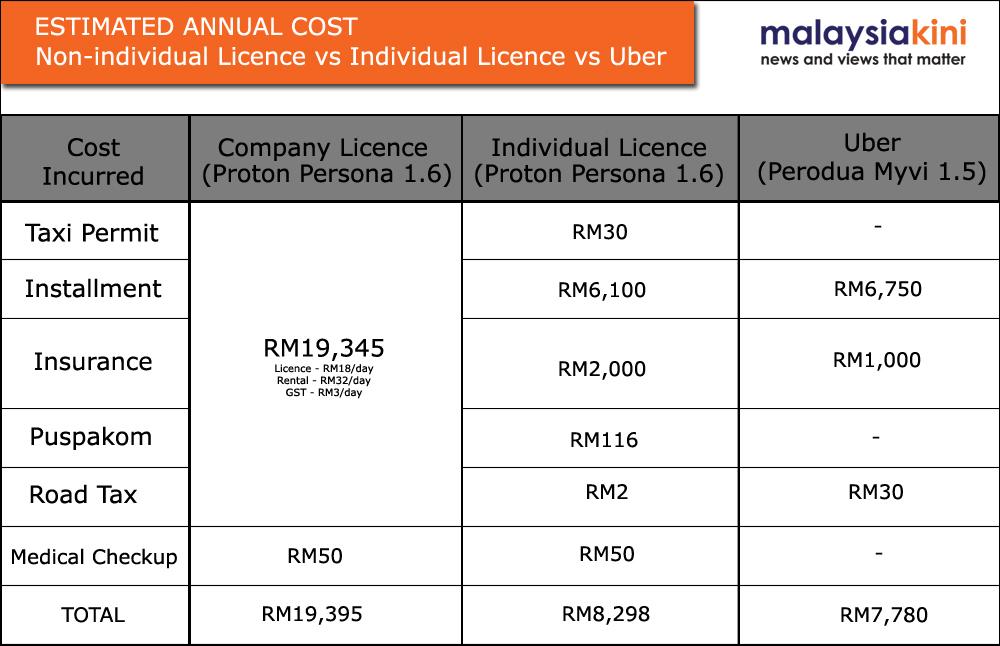FOCUS Angry taxi drivers are expected to converge in Kuala Lumpur next week to protest against the Land Public Transport Commission (SPAD) which has ignored their calls to outlaw Uber.
The planned protest on Nov 18 is in stark contrast to the Himpunan Teksi Rakyat 1Malaysia shortly before the 13th general election, where taxi drivers were delighted at Prime Minister Najib Abdul Razak's promise for individual taxi licences, grants for new vehicles and free tyres.
Yesterday, Malaysiakini in its first of a four-part series sought to explain why taxi drivers were angry at Uber as their income shrink following the rise of the mobile application.
However, the income of taxi drivers has long been depressed due to an exploitative system and the rise of Uber has exacerbate this, pushing taxi drivers over the tipping point.
In this second part, Malaysiakini looks at how taxi drivers in the Klang Valley are deprived of individual taxi licences because most of these go to well-connected private companies.
Taxi drivers who do not have the privilege of getting their own licence must turn to these private companies and pay a fee.
Such taxi drivers incur more than double the cost compared to those who can get their own licence, which is the case for most taxi drivers in the Klang Valley.
According to a parliamentary written reply in June this year, Selangor and Kuala Lumpur control 61 percent of all taxi licences in the country.
However, Selangor and Kuala Lumpur are also the only places in the country where most taxi drivers cannot get their own licence.
In Kuala Lumpur, a meagre 28.2 percent of licences are held by taxi drivers themselves while the remaining 71.8 percent are non-individual licences.
As for Selangor, individual licences stand at 48.9 percent while non-individual licences are at 51.1 percent.
This means almost three in every four taxi drivers in Kuala Lumpur are paying high fees without being able to own their own vehicle.

To illustrate, a Proton Persona 1.6 taxi driver with a non-individual licence must fork out about RM18 for the licence, RM32 for vehicle rental and RM3 in Goods and Services Tax daily, translating to a whopping RM19,345 a year.
The cost is substantially higher than a taxi driver who buys his own Proton Persona 1.6, provided that he is fortunate enough to obtain an individual taxi licence.
For those who have their own licence, their annual cost works out to just over RM8,000-RM6,100 in annual instalments for the Proton Persona (nine-year loan) and RM2,000 for commercial car insurance.
They must also foot for other miscellaneous costs such as annual Puspakom checks at RM116 and medical checkup at RM50.
Uber drivers are not statutorily required to undergo such checks.
If a Uber driver buys a Perodua Myvi 1.5, which is among the most popular model for the service, his cost only works out to around RM7,750 a year - RM6,750 in annual instalment for a nine-year loan and RM1,000 for a regular car insurance.
This means if a non-individual licence taxi driver makes RM60,000 a year, almost one third of his income will go to rental and licence fees.
This is excluding fuel and maintenance cost.
In contrast, with the same annual income, the yearly cost will only be slightly more than 10 percent for taxi drivers with individual licence and just under 10 percent for Uber drivers.
While taxi drivers have had the advantage of cheaper fuel cost, natural gas price was increased from 68 sen to RM1.05 per litre in October.
However, it is still cheaper than RON95 at RM2.05 in November.
With almost three in every four taxi drivers in Kuala Lumpur having to fork out heavy fees for a licence and vehicle that is not their own, it is no wonder customers often meet disgruntled taxi drivers in poorly maintained cars.
The rise of Uber has been a breath of fresh air for consumers as they can conveniently find nearby Uber drivers on their mobile phone and hail them.
Customers also do not need to worry about fleecing as the mobile app fixes the fare - which is divided 20-80 between Uber and the driver.
Drivers can also be rated and they could face a warning if their ratings were unsatisfactory.
 SPAD chairperson Syed Hamid Albar
(photo)
in an interview with
Malaysiakini
said taxi drivers should
"look in the mirror
" instead of blaming Uber and other similar services.
SPAD chairperson Syed Hamid Albar
(photo)
in an interview with
Malaysiakini
said taxi drivers should
"look in the mirror
" instead of blaming Uber and other similar services.
The former minister hit the nail on the head with his comment, but SPAD too must look into the mirror as the current monopoly of taxi licences is unsustainable following the 'Uber revolution'.
SPAD is already showing some positive signs as the commission announced on Monday that it was preparing proposals to reform the taxi industry but it is unclear when it will be completed.
Tomorrow, Malaysiakini will take a look at how other countries sought to end the Uber-taxi war and how Malaysia can learn from them.
RELATED STORIES
PART I: The taxi-Uber war: A tale of two drivers
PART III: Change - is the taxi industry ready for Uberfication?
PART IV: Insurers: Private car insurance does not cover Uber drivers

